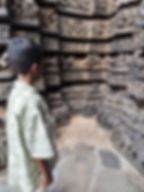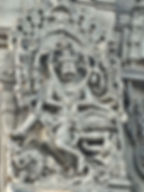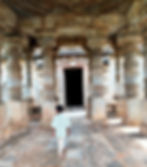The Timeless Hoysala Temples – History, Culture & Life in the 12th Century
- Ranjani
- Sep 1
- 4 min read
Updated: Sep 1
When we drove the 120 km from Madikeri to Belur, I didn’t quite expect the journey to transport us back in time. But that’s exactly what happened. The moment I stood before the temple, built in the 12th century by the Hoysala Dynasty, I felt like I had stepped into a living history book.

Every wall, every pillar, every sculpture had a story to tell. The sheer intricacy of the carvings is almost impossible to capture in words (though our pictures will give you a glimpse)—but being there in person, tracing your eyes along the star-shaped walls and ornate reliefs, is an experience you carry forever. This wasn’t just a temple visit. It was an immersion into an era when art, devotion, and daily life merged seamlessly into stone.
The Hoysala Legacy – An Empire of Art & Architecture
The Hoysala Dynasty ruled large parts of Karnataka between the 11th and 14th centuries, and their peak came in the 12th–13th century. While many kingdoms left their mark on South India, the Hoysalas distinguished themselves with something extraordinary: their temples. Over 300 temples still survive across Karnataka (though only about 70 have been studied in detail), each echoing the brilliance of a civilization that placed beauty and devotion hand in hand.
The most celebrated among them are now UNESCO World Heritage Sites:
Chennakesava Temple, Belur – dedicated to Vishnu, built by King Vishnuvardhana to celebrate a military victory.
Hoysaleswara Temple, Halebidu – twin temples dedicated to Shiva, famed for their storytelling walls.
Keshava Temple, Somanathapura – a masterpiece of balance, symmetry, and Vaishnava devotion.
Walking through these sites, you quickly realize—this wasn’t just about religion. These were places where artisans, philosophers, and storytellers poured their souls into stone.












What Makes Hoysala Temples Unique?
Standing at Belur, I couldn’t help but marvel at the distinct features that set Hoysala temples apart:
Soapstone Carvings – The temples are made of soapstone (chloritic schist), soft when quarried but hardening with time. This allowed artisans to chisel out delicate jewellery, hair strands, even fingernails on statues!
Star-Shaped Platforms (Jagati) – Unlike towering gopurams of Tamil Nadu, Hoysalas built low, expansive temples on raised star-shaped platforms. This design encouraged circumambulation, with devotees walking in a clockwise direction, following epic stories carved along the outer walls.
Everyday Life in Stone – Beyond gods and goddesses, you’ll find dancers, musicians, warriors, animals, even little scenes from daily life—like how a horse was reined or how ornaments were worn. These temples were also history books in sculpture.
The 12th-Century World of the Hoysalas
It’s fascinating to imagine life back then. The Hoysalas were great patrons of art and literature. The temples reveal so much about the lifestyle of the time:
Jewellery & Fashion – Sculpted figures are adorned with elaborate jewellery and intricate hairstyles, giving us a peek into the era’s trends.
Music & Dance – Many carvings depict dancers mid-pose or musicians with instruments, hinting at the cultural vibrancy of court life.
Religious Harmony – Though King Vishnuvardhana leaned towards Vaishnavism, the Hoysalas built temples for both Shiva and Vishnu, and even Jain shrines—reflecting a remarkable openness of spirit.
Water & Community Life – They also built beautifully ornamented stepped tanks (Kalyanis), like the one at Hulikere, which became social and ritual hubs.













Stories Etched in Stone
Perhaps the most breathtaking aspect is how these temples retell the great Hindu epics. At Halebidu, the outer walls unfold like a visual Ramayana and Mahabharata. Every panel flows into the next, allowing worshippers to relive these timeless tales as they circumambulate the temple. You’ll also see depictions of gods in their various forms:
Shiva with Parvati, or as Nataraja dancing on the head of an elephant-demon.
Vishnu in his many avatars—Varaha (the boar), Narasimha (the lion-man), Krishna lifting Govardhana hill, and more.
Durga slaying the buffalo demon.
What’s fascinating is that the artisans signed their work—the first known instance of signed art in India. Imagine the pride they must have felt, leaving their names behind on sculptures that still stand strong 900 years later.
Why the Hoysala Temples Still Matter
As I walked out of Chennakesava Temple that evening, I kept thinking—these weren’t just places of prayer. They were symbols of an empire that believed in celebrating life through art. The Hoysalas showed us that devotion can be beautiful, that architecture can be a storyteller, and that culture can thrive when inclusivity and creativity walk hand in hand.
“It’s remarkable that these three temples in Belur, Halebidu, and Somanathapura were finally recognized as a UNESCO World Heritage Site in 2023, highlighting their universal value as masterpieces of human creativity"
And trust me—while pictures can give you a taste, standing there in person is something else entirely.








So if you ever plan a trip through Karnataka, don’t miss Belur, Halebidu, and Somanathapura. They’re not just temples; they’re time machines carved in stone.
References & Further Reading
UNESCO – Sacred Ensembles of the Hoysalas: Designates Belur, Halebidu, and Somanathapura as a World Heritage Site (2023). Discusses architectural brilliance like star-shaped plans, circumambulatory paths, friezes, and sculptural detail.
Wikipedia – Hoysala architecture: Chronicles the timeline (11th–14th centuries), architectural style, and notes that only ~70 of ~300 temples have undergone detailed study.


